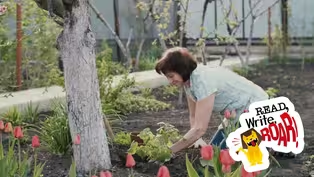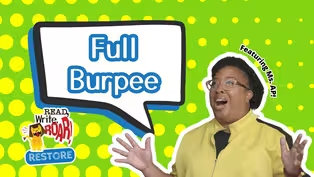Read, Write, ROAR!
Pollination Power: Native Bees | Venn Diagrams for Grades 4-5
Clip: Season 1 Episode 1022 | 6m 25sVideo has Closed Captions
Join Mr. Peterson as he explores two native Michigan bees and their role in pollination.
Have you heard all the buzz about bees lately? Join Mr. Peterson as he explores two native Michigan bees and their role in pollination. Plus, learn how a Venn diagram can help organize your thoughts and improve your writing skills when comparing and contrasting!
Problems playing video? | Closed Captioning Feedback
Problems playing video? | Closed Captioning Feedback
Read, Write, ROAR! is a local public television program presented by Detroit PBS
Read, Write, ROAR!
Pollination Power: Native Bees | Venn Diagrams for Grades 4-5
Clip: Season 1 Episode 1022 | 6m 25sVideo has Closed Captions
Have you heard all the buzz about bees lately? Join Mr. Peterson as he explores two native Michigan bees and their role in pollination. Plus, learn how a Venn diagram can help organize your thoughts and improve your writing skills when comparing and contrasting!
Problems playing video? | Closed Captioning Feedback
How to Watch Read, Write, ROAR!
Read, Write, ROAR! is available to stream on pbs.org and the free PBS App, available on iPhone, Apple TV, Android TV, Android smartphones, Amazon Fire TV, Amazon Fire Tablet, Roku, Samsung Smart TV, and Vizio.
Providing Support for PBS.org
Learn Moreabout PBS online sponsorshiphave you heard all the buzz about bees lately I know I have hey it's me Mr Peterson and today we're going to examine two bees that are native or found naturally in Michigan bees can definitely be described as busy busy transferring pollen between plants but what is pollen pollen is a substance created by plants needed to help them to go to seed or produce fruit some of you might be allergic to pollen that's because it's usually a fine powder that can make us sneeze I guess that makes sense because the Latin meaning for pollen is fine flour like what we use to bake cookies pollinators like bees help to pollinate and that means that they spread the pollen from one plant to another to help them go to seed and produce fruit this whole process is known as pollination if you look carefully you can see the root word of pollen in the words pollinate pollinator and pollination the spelling changes just a bit with the E and pollen changing into an I when we add a suffix but all of these words are related in meaning now let's learn about two different kinds of bees who are native to Michigan and who work as pollinators take notes with me as we learn then I can use use those notes to help write a comparison the first Native bee is the Mason bee Mason bees are solitary bees this means they live alone and don't live in colonies or groups like The non-native honeybee Mason bees live underground and get their name because they use mud or Mason products to construct their nest inside of the empty stem or tube humans that work with brick and mortar or mud are known as Masons in the tube the bee lays an egg then it adds some pollen that is collected from flowers for the larvae to eat before the larvae Hatches the Mason bee protects it by packing in some mud into that tube the Mason bees usually build their nest in the months of May and June the second species of bee is the leaf cutter bee solitary and living underground they also get their name from how they build their nest they use their mandibles which are sharp mouth parts used to cut pieces of leaves they lay an egg add some pollen that it collected from the flowers for the larvae to eat when it hatches and then protect it by packing in the piece of leaf they cut leaf cutter bees usually build their nest in the month of July since I'm comparing two different types of bees the Mason and the leaf cutter bees I'm going to use a fin diagram a Vin diagram has two circles that overlap in the center in this overlap I'll write what is aike or similar about the two kinds of bees in the parts of the circle that do not overlap I will label one side Mason bees and one side leaf cutter bees and write what is different about them okay so we learned that both bees are native or found naturally in Michigan we also learn that they both live underground both bees use empty stems or tubes to build the nest for laying eggs and putting in some pollen for the larvae to eat now let's look at the differences the Mason bee uses mud to make its nest and the leaf cutter uses leaves the Mason bee builds the nest in the months of May and June and the leaf cutter builds the nest in July the leaf cutter bee also has special mandibles to help it cut leaves let's check out a comparison writing I did because this is a comparison writing I use the following words and phrases I use similarities differences but additionally these are all frequently found in this type of writing while I'm reading aloud follow along so you can see how the ven diagram helped me organize in write my comparison paper there are two bees in Michigan that have many similarities some also have some differences Mason bees and leaf cutter bees are both bees that are native to Michigan and live underground additionally each species uses tubes or Hollow sticks to build their nest and pack pollen in the tubes after laying an egg so the hatching larvae has food to eat when looking at these two native bees it is equally important to notice some of the differences they display to protect the larvae and pollen the Mason bee uses mud but the leaf cutter bee uses pieces of leaves that it cuts with its sharp mouthpiece known as a mandible finally they both build their nest at different times in the year the Mason bead are first to perform this task in May and June while the leaf cutter bee does it in July even though these important pollinators behave like each other in some ways they also have Behavior AV that make them unique from each other what do you think we just learned a lot we learned about the process and importance of pollination and how to use a VIN diagram to help us organize our information and notes in order to do comparison writing pollen can make us sneeze and bees might make us a bit nervous but there's no denying how important native pollinators are to the world around us [Music]
Create an Underwater Soundscape | Ms. Audra | Read, Write, ROAR!
Video has Closed Captions
Clip: S1 Ep1022 | 2m 18s | Dive into the ocean with Miss Audra! Explore the sounds of whales, fish, and bubbles. (2m 18s)
How to Create a Strong Setting in Film | Ms. Kara | Read, Write, ROAR!
Video has Closed Captions
Clip: S1 Ep1022 | 4m 29s | Discover how the setting in film contributes to the overall story. (4m 29s)
Native Plants: Transforming Urban Landscapes | LaDonna Mask | Read, Write, ROAR!
Video has Closed Captions
Clip: S1 Ep1022 | 7m 31s | Explore how native plants can transform urban areas! (7m 31s)
Read, Write, ROAR! Restore - Full Burpee
Video has Closed Captions
Clip: S1 Ep1022 | 2m 24s | Full Burpee: Join Ms. AP in a dynamic 2-minute movement snack focusing on jumping burpees. (2m 24s)
Providing Support for PBS.org
Learn Moreabout PBS online sponsorship

- Home and How To

Hit the road in a classic car for a tour through Great Britain with two antiques experts.












Support for PBS provided by:
Read, Write, ROAR! is a local public television program presented by Detroit PBS




